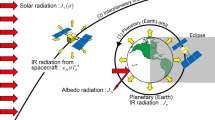Abstract
A method is proposed for a quantitative assessment of protective properties of a spacecraft shielding structure at hypervelocity impact. The method uses a multilayer recording target, which is placed outside the shield. An experimental study has been conducted of mesh shield resistance to micrometeoroid/orbital debris damage, which has confirmed an enhancement of protective properties for a cascade arrangement of meshes (first a coarse mesh, then a fine one) and in the case of substituting a corrugated mesh for a flat one.








Similar content being viewed by others
REFERENCES
Bagrov, A.V., Leonov, V.A., and Sorokin, N.A., Meteor hazard for interplanetary flights in the ecliptic plane, Sol. Syst. Res., 2019, vol. 54, no. 7, pp. 587–594.
Bezrukov, L.N., Gadasin, I.M., Myagkov, N.N., and Shumikhin, T.A., Testing a prototype of spacecraft protection against meteoroids and orbital debris, Mekh. Kompoz. Mater. Konstr., 2014, vol. 20, no. 4, pp. 646–662.
Christiansen, E.L. and Kerr, J.H., Mesh double-bumper shield: a low-weight alternative for spacecraft meteoroid and orbital debris protection, Int. J. Impact Eng., 1993, vol. 14, pp. 169–180. https://doi.org/10.1016/0734-743X(93)90018-3
Dobritsa, D.B., Gerasimov, A.V., Pashkov, S.V., and Khristenko, Yu.F., RF Patent 2623782, 2017.
Dobritsa, D.B., Pashkov, S.V., and Khristenko, Yu.F., Study of the efficiency of corrugated mesh shields for spacecraft protection against meteoroids and manmade space debris, Cosmic Res., 2020, vol. 58, no. 2, pp. 105–110. https://doi.org/10.1134/S0010952520020021
Gerasimov, A.V., Dobritsa, D.B., Pashkov, S.V., and Khristenko, Yu.F., Theoretical and experimental study of a method for the protection of spacecraft from high-speed particles, Cosmic Res., 2016, vol. 54, no. 2, pp. 118–126. https://doi.org/10.1134/S0010952516020015
Gerasimov, A.V., Pashkov, S.V., and Khristenko, Yu.F., Theoretical and experimental study of the impact interaction of fragments with various types of spacecraft protection, Mekh. Deform. Tverd. Tela. Vestn. Nizhegorod. Univ. im. N.I. Lobachevskogo, 2011, no. 4, pp. 1433–1435.
Gongshun, G. and Ruitao, N., Numerical simulation of hypervelocity impact on mesh bumper causing fragmentation and ejection, Key Eng. Mater., 2013, vols. 525–526, pp. 401–404. doi 10.4028/www.scientific.net/KEM.525-526.401
Horz, F., Cintala, M.J., Bernhard, R.P., and See, T.H., Multiplemesh bumpers: a feasibility, Int. J. Impact Eng., 1995, vol. 17, pp. 431–442. https://doi.org/10.1016/0734-743X(95)99868-R
Ivankov, A.A., Kurshakov, M.Yu., and Tverdokhlebova, E.M., A computational study of the spacecraft’s own external atmosphere developed by the Lavochkin association, Sol. Syst. Res., 2020, vol. 55, no. 7, pp. 717–724. https://doi.org/10.1134/S003809462107008X
Markov, A.V., Konoshenko, V.P., Beglov, R.I., Sokolov, V.G., et al., The main directions and results of work to protect the ISS Russian segment from meteoroids and space debris, Kosm. Tekh. Tekhnol., 2018, no. 4, pp. 16–28.
Sanchez, G.A. and Christiansen, E.L., FGB Energy Block Meteoroid and Orbital (M/OD) Debris Shield Test Report JSC-27460, Houston, TX: NASA, Johnson Space Center, 1996.
Shumikhin, T.A., Myagkov, N.N., and Bezrukov, L.N., Distribution of kinetic energy between morphologically distinct parts of a cloud of impactor fragments when breaking through thin discrete barriers, Mekh. Kompoz. Mater. Konstr., 2014, vol. 20, no. 2, pp. 319–331.
Shumikhin, T.A., Myagkov, N.N., and Bezrukov, L.N., Properties of ejecta generated at high-velocity perforation of thin bumpers made from different constructional materials, Int. J. Impact Eng., 2012, vol. 50, pp. 90–98. https://doi.org/10.1016/j.ijimpeng.2012.06.008
Putzar, R. et al., Screening tests for enhanced shielding against hypervelocity particle impacts for future unmanned spacecraft, 6th European Conf. on Space Debris, Darmstadt, Germany, 2013, vol. 6.
Funding
This work was supported by the Russian Science Foundation, project no. 16-19-10264.
Author information
Authors and Affiliations
Corresponding authors
Ethics declarations
The authors declare that they have no conflicts of interest.
Additional information
Translated by A. Kobkova
Rights and permissions
About this article
Cite this article
Dobritsa, D.B., Yashchenko, B.Y., Pashkov, S.V. et al. Experimental Study of the Resistance of Corrugated Mesh Micrometeoroid/Orbital Debris Shields. Sol Syst Res 56, 553–561 (2022). https://doi.org/10.1134/S003809462207005X
Received:
Revised:
Accepted:
Published:
Issue Date:
DOI: https://doi.org/10.1134/S003809462207005X




